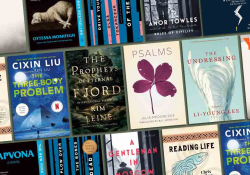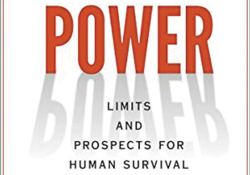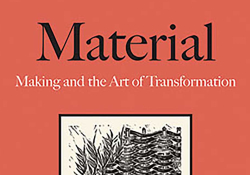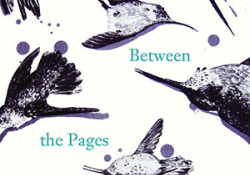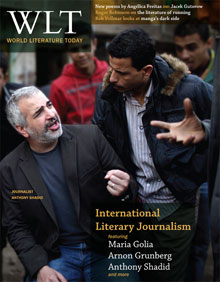Dark Side of the Manga: Tezuka Osamu's Dark Period
Tezuka Osamu spent the first two decades of his career entertaining Japanese children with his manga like Tetsuwan Atomu, but the rigors of being Japan's most visible creative public icon sent him down a dark path that would transform both his career and his legacy.
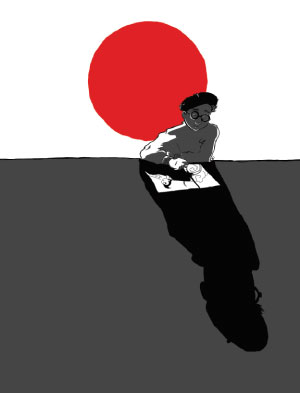
As global economies lurch from the popping of financial bubble after bubble, industrialized nations with identities forged in the aftermath of World War II are looking back on past histories, both near and far, with longing—a comingling of the urge to retreat into a cultural memory of triumph while searching for the elusive path back to greatness. Japan is no exception. The success of novels like Murakami Ryū’s Popular Hits of the Shōwa Era (2011; see WLT, Sept. 2011, 63) and Urasawa Naoki’s manga 20th Century Boys (1999–2006) is a telling sign that many Japanese people are reacting to current economic and social instabilities by dissecting the remains of their country’s dynamic recent past for answers to modern problems.
The Shōwa period began in 1926 with the ascension of Hirohito to the imperial throne of Japan. Despite the more popular contemporary conception of the Shōwa as being framed at one end by the conclusion of World War II and, at the other, by Hirohito’s death in 1989, the period, as a whole, was more complicated than that simple narrative suggests. It began with the collapse of a fledgling democracy that led to an expansionist military state, which, in turn, was transformed into a pacifist industrializing nation fighting its way back from the brink of starvation and ruin. From there, Japan emerged as one of the world’s manufacturing powerhouses and, for a short time, its banker, before the death of the emperor coincided with the collapse of the country’s financial house of cards at the end of the 1980s.
To gain a more nuanced understanding of the whole of the Shōwa period, we need look no further than the work of twentieth-century Japan’s most influential cultural icon, manga artist Tezuka Osamu. Tezuka’s entire life was contained within the Shōwa, born two years after it began and, himself, dying of stomach cancer at the age of sixty, within one month of the emperor’s own passing. An in-depth examination of how Tezuka’s output relates to the Japanese culture of which he was a product, a participant, and a prophet is an undertaking that goes well beyond the scope of one magazine article. One period in his career, however, offers the inquisitive reader a fascinating cross section that yields insights into the Shōwa period’s shaky beginnings, its turbulent middle, and concerns for its future.
Welcome to Tezuka Osamu’s dark period.
Tezuka was born to parents more philosophically in tune with the tech-savvy, freewheeling Japan of the 1920s than the Japan reduced to an occupied nation under General MacArthur’s authority in 1945. He detested war and the belligerent nationalism (no matter the nation) that characterized the decade in which he grew to young adulthood. Tezuka was a quiet boy obsessed with drawing, and, at the war’s end, he channeled that single-minded focus into attending medical school. When Tezuka completed his studies in 1948, he was faced with a dilemma. He had been drawing manga all through school, despite the demands of his education. In one of the great improbable decisions of the twentieth century, he decided not to practice medicine and, instead, began trying to sell his work to cash-strapped book publishers.
Tezuka's singular vision of the future, a world rich with technology but plagued by the same ethical problems as the world his audience inhabited, captivated the imagination of many young Japanese children and, in measurable ways, shaped the nation's future as those children grew to adulthood.
No one could have predicted the degree of his success, as no manga-ka had seen his kind of success before. Among a string of wildly successful works, one series stood out, seizing the cultural zeitgeist of Japan in the 1950s like none other: Tetsuwon Atomu or Astro Boy. An entire generation of Japanese children grew up following the exploits of “The Mighty Atom,” a powerful boy robot with a tender heart but an active sense of justice. Tezuka’s singular vision of the future, a world rich with technology but plagued by the same ethical problems as the world his audience inhabited, captivated the imagination of many young Japanese children and, in measurable ways, shaped the nation’s future as those children grew to adulthood.
By 1960 Tezuka was more than a creator—he was an icon. As his activities began to diversify into animation, his audience grew older, and a new generation of artists slowly began to chip away at his unquestioned status as the preeminent storyteller of his time. A new style, called gekiga, appealed to a readership that was not only aging but beginning to question the foundations of Japan’s national ethos. At first, Tezuka was openly derisive of the idea that manga could be responsibly produced for audiences other than children. He was, however, a relentlessly competitive man, and as his ventures in the world of animation first overtook his life and then consumed his fortune, Tezuka returned to the idea and embraced it with a vengeance in an attempt to reinvent himself and his legacy.
Though his palette of topics expanded by writing for an audience other than children, Tezuka demonstrates the same interest in utilizing storytelling as a tool for moral instruction. His work during this dark period also shows a similar dedication to social justice and the intolerance of hypocrisy that characterizes his work on Tetsuwon Atomu. One is tempted, given Tezuka’s background in medicine, to treat these pieces as a narrative biopsy, as each diseased layer of culture is cut away from the body politic and examined closely under a microscope in order to assess the overall health of the patient, which in this case is the Japanese culture that has undergone round after round of transformative therapy and seems now in danger of dying by virtue of the cure itself.
Tezuka initiated this phase of his career in 1968 with a work titled Swallowing the Earth. A brief prelude establishes that an eerie cabal of beautiful sisters are plotting in a subterranean temple to bring about the downfall of civilization. The story proper begins during World War II in Guadalcanal and introduces the reader to two men, both soldiers, who become obsessed with a photo of a woman named Zephyrus. She is presented as the very embodiment of beauty, her image alone capable of driving any man to madness by way of obsession.
As the plot is transported into the present, we start to gain a clearer picture of his targets. The two soldiers have aged twenty years, and one of them is now the CEO of a corporation while the other has languished in poverty. The wealthier man becomes convinced that he has seen the Zephyrus of their youth in Japan and hires his former compatriot’s son to try and find her. Through this device, Tezuka creates his protagonist, Seki Gohonmatsu. He’s an odd hero, half Popeye, half Li’l Abner. The only lust in his heart is for alcohol, and it serves in the story as his spinach. This caricature of masculinity not seeking its female complement functions as the perfect foil to the feminine aspect that seeks to destroy its masculine counterpart.
The most successful parts of the story dwell on the symbiotic relationship between Japan and the United States, both culturally and economically. Our initial introduction to Zephyrus actually comes through an American POW, and the sisters are presented as being Western women, blonde and voluptuous, in clear contrast to several clearly Japanese women who round out the cast. The Japanese businessmen exhibit a dual function in the story, kingmakers in their own nation and otherwise subordinate to American interests. Money is often laid at the foot of every evil that springs up in the story, and Gohanmatsu is idealized as the “hero” by his total lack of interest in money and the sex and power that emanates from possessing it.
It is worthwhile to note that while Swallowing the Earth does represent a narrative departure from his earlier work, Tezuka’s visual approach to storytelling only shows subtle signs of development away from his traditional style. Heavily influenced in his formative period by American animation, Tezuka retained a strange dichotomy in his work throughout his career, characterized by the juxtaposition of round, bouncy-looking figures engaged in progressively disturbing actions. The restless experimentation of his page layouts had been a trademark of his work since the 1950s, and though his work through this period continues to exhibit this same tendency, it’s difficult to pinpoint precisely how the introduction of this darker material into his body of work might have altered his approach to the page.
One is tempted to treat these pieces as a narrative biopsy, as each diseased layer of culture is cut away from the body politic and examined closely under a microscope in order to assess the overall health of the patient.
What is more noticeable is his departure from his traditional “star system” of character design. One of Tezuka’s eccentricities was to reuse basic character archetypes from work to work so that characters would seem familiar to readers even before their roles in the story were made clear. Some have noted that this device also shows Tezuka’s love for film, by envisioning his characters as actors who brought some measure of their previous roles into each new work.
Another feature common to his work prior to this period was the use of repeating visual gags that would temporarily bring the reader out of the story and remind them that this was, after all, just a work of fiction. While these welcome figures like The Spider, the Hyoutan-Tsugi, and even Tezuka himself would reappear in later works, their absence from these pieces is notable. During his dark period, Tezuka abandons this approach and develops the characters from whole cloth.
Swallowing the Earth is a tantalizing glimpse of what Tezuka is capable of when the parameters of writing specifically for children are removed. It displays, however, hallmarks of his earlier work, featuring a goofy but down-to-earth protagonist who exhibits no actual human frailties beyond a fascination for liquor. Even Tezuka’s experimentation with introducing sexuality into the work comes off as half-hearted, the sex act often hidden behind psychedelic flourishes or deferred to a place off-panel. Two later works, Ayako (1972–73)and MW (1976–78), however, place sex squarely at the center of his narrative ambition.
In MW, Yuki Michio is transformed into a psychopath by a traumatic experience as a child when his family is taken hostage by a band of young anarchists. He is raped by a member of the group, but the pair end up as lifelong confidants as they bear witness to a government testing program of an experimental gas called “MW” that kills everyone on the island, including the other anarchists and Yuki’s family. Yuki’s rapist, Garai, responds to the incident by becoming a Catholic priest, seeking redemption through his faith. Yuki, in contrast, becomes a sadistic murderer who kidnaps, rapes, and tortures his way toward his goals of exposing those responsible for the MW incident and, ultimately, using the gas to wipe out the human race.
Politics are a common target in these works, and Tezuka offers little in the way of comfort regardless of where one looks on the ideological spectrum. Big business and government bureaucracy are shown as stubbornly intertwined. The sociopathic Yuki navigates his outward spiraling journey of revenge through channels that begin in a bank but wind seamlessly through government and the military. Anarchist groups that might provide some avenue for reform are portrayed as ineffectual and easily manipulated by Yuki into furthering his agenda, though he shares none of their ideological aims.
In both Swallowing the Earth and MW, Tezuka shows a narrative and visual fascination with the idea of an island as a place with which the progressive urbanization of Japan could be contrasted. This bears a certain degree of irony as, to many westerners, Japan was still thought of as a naturalist’s paradise where the ancient and the modern could coexist side by side. In reality, Japan’s rush to modernize sacrificed many of its natural wonders, and ecotourism among the Japanese replaced a more traditional cultural value of living within nature rather than gazing at it through the windows of a high-speed train. Tezuka spends a good deal of visual real estate lavishly representing these unspoiled environments, a tendency that would reach its climax in his epic retelling of the life of the Buddha.
While both of the works considered thus far use a mixture of naturalist and fantastic elements to make observations and criticisms about postwar Japan, none do it with the directness of Tezuka’s dark masterpiece, Ayako. In it, the Tenge family becomes a metonymy for the whole of Japan as its various members occupy different archetypes within the transforming culture.
The story opens with the return of Jiro, the second oldest son who was taken as a prisoner of war by the Americans. His family once held large swaths of land, with retainers farming the land in a system that might be most closely associated with sharecropping in the United States. When the war comes to an end, the government, as directed by the American occupation force, seizes the land and redistributes it, leaving their social and financial status in jeopardy. The most surprising change to the family in his absence, however, is a new young sister, Ayako. In short order, we discover that Ayako is the product of a deal made between Jiro’s father and his eldest brother. In exchange for the promise of inheriting the whole of the family’s remaining lands, his brother has allowed his father to have sex with his young wife and reproduce.
Tezuka utilizes his intertwining plots to demonstrate how the lust for power and money warps the values of nearly every character in the story, with only Ayako left untouched by corrupting influences. The Tenge family, once privileged by the social arrangement that existed prior to the war, lose any sense of moral commitment to either family or nation as they strive to retain their place in the culture. Though their father’s shortcomings as a lecherous bully are certainly odious, they pale in comparison to the depravity that unspools from his children’s human frailties. Existing within the story as something of a cypher, Ayako plays an important role as a mirror unblemished by socialization, by which we may appreciate the epic nature of their many tragic moral failures.
Occupying a unique position in time, Tezuka Osamu was able to assess at least three different Japans that had existed in his life: the early Shōwa period Japan of increasing militarization and hardship; the postwar Japan occupied and shaped by a foreign power that had reduced it to ruin; and the polarized Japan of the 1960s that saw great wealth amassed against a backdrop of unrest and, in some cases, outright oppression of people and ideas that did not support the popular narrative of better times. In looking over these works that fixate on the contrasts and similarities between these three periods, we may be led to conclude that this new Japan was built upon contradictions that Tezuka, even with his insightful mind and keen imagination, could never resolve. His fantastic narratives, born out of a new freedom of content and audience expectations, led over and over to a ruinous end for his characters. If it was a literal apocalypse that ushered in the era that found him emerging as one of Japan’s most beloved cultural icons, figurative ones haunted the end of each of these stories he dreamed up to examine and criticize the nation that Japan had become.
Though the beginning of this dark trend in his work is easy to identify, finding its end is more elusive. Tezuka devoted the rest of his life to promoting the idea that manga could appeal to readers of any age and interest, essentially co-opting the very idea against which he had railed once so vehemently. But, after a certain period of time, the venom contained within these early works becomes transmuted into something less threatening and more sustainable. The works that follow would stretch out for multiple volumes and would be identified by many of his critics as the culmination of his many decades of work as a manga artist.
Rather than allowing himself to be consumed by his disappointment and disapproval of his nation, Tezuka’s scope expanded to a more global perspective that allowed him to conceive of these shortcomings as human rather than specifically Japanese. Though Hirohito, known in his death as the Shōwa emperor, and Tezuka would both die just before Japan’s economic miracle transformed into its lost decade, these works make it clear that the fault lines of its eventual downfall were clearly exposed to those close enough to see them. As modern Japanese people look back to the Shōwa period with nostalgia, Tezuka’s legacy remains to remind them that the good old days are rarely ever all that good.
University of Science and Arts of Oklahoma
